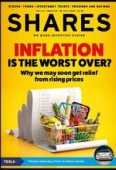Archived article
Please note that tax, investment, pension and ISA rules can change and the information and any views contained in this article may now be inaccurate.
Inflation is the worst over? Why we may soon get relief from rising prices

Inflation is running at 40-year highs with June consumer prices increasing by more than 9% year-on-year on both sides of the Atlantic.
Unsurprisingly it continues to grab headlines and keeps investors’ attention firmly fixed on central bank interest rate rises designed to cool the economy.
Supply shortages created by the reopening of the world economy have been exacerbated by the war in Ukraine and China’s zero Covid policy.
Meanwhile, financial sanctions against Russia have sent energy prices rocketing sky-high.
The narrative has become firmly established. But Shares believes the investment focus will likely shift over coming months.
That is because the key drivers of inflation are abating which suggests investors would be better served by ignoring the scary headlines. The key reasons are explored shortly.
One point to note is that even if inflation does cool there is still a lot of uncertainty about how fast it might fall back towards central bank policy targets. So, it is likely that companies with pricing power will remain in demand with investors.
REASON 1: COOLING COMPONENTS
Beneath the headline data key components which have been driving inflation higher appear to be softening.
Brent crude prices have moved sharply lower since the end of June falling by a fifth while natural gas prices off by almost a third. A part of this weakness may reflect fear of a growth slowdown or recession as higher energy prices destroy demand.
The idea is that consumers spend less on discretionary items because energy costs are taking a higher share of wallet.
Food prices look like they peaked in May with wheat prices down almost 40% while all commodities across the spectrum have been soft in recent weeks.
Prices are likely to remain under pressure following an agreement reached (22 July) in Istanbul which allows a resumption of Ukrainian shipment of grain and other agricultural products through the Black Sea to world markets.
The agreement also allows Russia to export grain and fertilisers, easing worries over global food security. A control centre will be set-up in Istanbul which oversees exports. It will be run
by staff from the United Nations, Turkey, Russia, and Ukraine.
Commodities across the board have been softening, with the broad-based S&P GSCI Commodity Index down by nearly a fifth since early June.
Meanwhile supply chain stresses have eased, reducing the soaring shipping costs which have been a major drag for certain companies.
REASON 2: INFLATION WILL SLOW MATHEMATICALLY
The so-called inflation base effect relates to the effect of the corresponding prior year period.
From June 2022 onwards the inflation data series will reflect a true like-for-like comparison of the economy for the first time since the pandemic.
Weak inflation data from the prior year will drop out of the series which means even an absolute increase in prices will show a lower year-over-year rate of inflation.
REASON 3: INFLATION EXPECTATIONS NOT EMBEDDED
The reason the Federal Reserve and to some extent the Bank of England have been so aggressive in hiking interest rates is because they are afraid that expectations of higher inflation have become embedded in the consumer psyche.
It was undoubtedly a relief therefore, when the University of Michigan’s consumer confidence survey (15 July) showed households’ inflation expectations in five years’ time falling to 2.8% from 3.1% in the prior month.
Consumer expectations for inflation are consistent with the bond market’s view of where inflation will be in five years’ time, currently around 2%, down from 2.6% in late April according to the St Louis Federal Reserve.
Consumers and bond investors are not alone. The latest Bank of America fund manager survey (19 July) revealed that 76% of respondents expected inflation to fall next year, the most since the financial crisis in 2008.
The survey also indicated that investor optimism on global growth hit all-time lows, while those expecting a recession next year shot to the highest level since May 2020.
There is no certainty that inflation will slow, but the growing evidence suggests actions by the US Federal Reserve and other central banks are having a cooling effect on economic growth, alleviating some inflationary pressures.
One other interesting aspect to be revealed by the fund manager survey is a clear investor preference for corporates to shore up their balance sheets rather than spend cash on capital expenditures or share buybacks.
The problem is the act of hoarding cash instead of investing for growth could exacerbate the growth slowdown and tip the economy into a recession.
WINNERS AND LOSERS
Investors will get a better understanding of the impact of higher rates and inflation over coming weeks as the second quarter reporting season gathers pace.
With the inflation tide potentially turning the biggest beneficiaries of tight energy markets over the last few months look the most vulnerable to an easing in prices.
In other words, investors should consider taking profits in the oil and energy sectors which have performed very well in 2022.
Oil giants BP (BP.), Shell (SHEL) and Drax (DRX) are showing gains of 17%, 27% and 22% respectively.
Slowing growth expectations are dampening industrial metals prices. This was confirmed by Rio Tinto’s (RIO) latest production report when the company said, ‘Prices for our commodities decreased in the quarter, amidst growing recession fears and a decline in consumer confidence.
‘The economic outlook is weakening due to the Russia-Ukraine war, tighter monetary policy to curb rising inflation, and targeted Covid-19 restrictions in China.’
Miners’ profits are directly linked to metals prices, so it is perhaps unsurprising that analysts have already begun to lower their earnings estimates in recent weeks.
Forecast 2022 earnings per share for Rio have dropped by around 18% since the middle of May.
A combination of escalating claims inflation and declining volumes sparked profit warnings from Sabre (SBRE) and Direct Line (DLG) in July.
Increased parts costs and longer repair times due to labour shortages have caught the insurers by surprise.
At the same time a change in the regulations which prevents the insurers from automatically increasing premiums for existing customers has held back the ability to pass this on.
SUCCESSFULLY PASSING ON COSTS
The paper and packaging industry has managed to absorb rising input costs by raising prices.
DS Smith (SMDS) told investors at its annual results that price increases had offset significant cost inflation which had driven a strong improvement in profitability.
However, despite the increase in profitability, the shares are down 26% year-to-date perhaps reflecting a normalisation of e-commerce trends as cash-strapped consumers cut back on online shopping.
Mr Kipling cakes maker Premier Foods (PFD) said it was on track to meet full year expectations after successfully putting through price increases to offset cost inflation.
Premier Foods, whose other brands include Ambrosia and Lloyd Grossman claimed its good value meal proposition was proving popular as consumers grapple with a cost-of-living crisis.
Instant service equipment company Photo-Me International (PHTM) increased prices in its photo booths by a third in the first half without impacting revenues, allowing it to mitigate inflationary pressures, demonstrating significant pricing power.
US electric vehicle maker Tesla (TSLA:NASDAQ) managed to offset lower volume growth caused by supply issues by increasing pricing by around 5% since May noted investment bank Berenberg.
US snacks and beverage giant PepsiCo (PEP:NYSE) raised full year guidance (12 July) after planning to increase prices in the coming months. The Gatorade and Doritos maker said it had not seen any resistance to the price rises.
It is worth pointing out that companies are not forced to raise prices to combat inflation and are free to choose to absorb the costs to drive volumes and market share gains.
Premium mixers drinks maker FeverTree (FEVR:AIM) is a good example. The company surprised investors (15 July) after downgrading full year profit expectations by a whopping 36%.
The company cited higher than expected glass and raw materials costs as reasons for a deterioration in margins. It also suffered delays in ramping up its US East Coast bottling facility which resulted in higher freight costs as UK production was needed to fulfil demand.
A knock-on effect of lower inflation is that interest rates rises may also be close to peaking out. This could reduce pressure on high growth companies which have been heavily punished by higher rates, which lower the value of their future earnings.
In other words, it could be a good time to reconsider growth companies which have good pricing power.
Technology giant Apple (AAPL:NASDAQ) has consistently shown it has the ability to raise prices without affecting demand for its products.
Important information:
These articles are provided by Shares magazine which is published by AJ Bell Media, a part of AJ Bell. Shares is not written by AJ Bell.
Shares is provided for your general information and use and is not a personal recommendation to invest. It is not intended to be relied upon by you in making or not making any investment decisions. The investments referred to in these articles will not be suitable for all investors. If in doubt please seek appropriate independent financial advice.
Investors acting on the information in these articles do so at their own risk and AJ Bell Media and its staff do not accept liability for losses suffered by investors as a result of their investment decisions.
Issue contents
Exchange-Traded Funds
Feature
- Tesla’s undoubted progress still unlikely to change the minds of fans or sceptics
- Inflation is the worst over? Why we may soon get relief from rising prices
- Why Johnnie Walker-owner Diageo is a wonderful stock to own
- Find out which sectors in emerging markets are the cheapest
- Emerging markets: Views from the experts
Great Ideas
Investment Trusts
News
- Coca-Cola provides new demonstration of its pricing power in Q2
- Pressure mounts on Vodafone to find acquisition fix for growth conundrum
- Link report reveals 40% UK dividend growth for Q2 but also concentration risk
- Abcam deals big blow to UK investors in battle to list growth companies
- Why athleisure is holding up but demand for fast fashion is fading

 magazine
magazine








